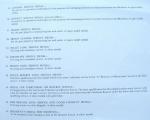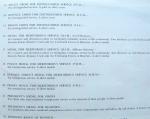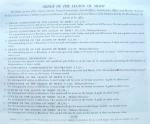-
Posts
13,225 -
Joined
-
Last visited
-
Days Won
22
Content Type
Profiles
Forums
Blogs
Gallery
Events
Store
Everything posted by Mervyn Mitton
-

Zulu items
Mervyn Mitton replied to helen's topic in Great Britain: Militaria: Badges, Uniforms & Equipment
Yes - an old Zulu Isiphapha - with cow tail binding. Use a little furniture polish on the shaft - when handled regularly, they get a nice sheen. -

Zulu items
Mervyn Mitton replied to helen's topic in Great Britain: Militaria: Badges, Uniforms & Equipment
Pity,Mike - a good axe at least ?1000 ! -
Helen - nice to have the extra photos. What does surprise me is that the barrel is rifled - wouldn't have thought it necessary on a wall gun ? Marks do look Turkish and that looks like an Arabic numeral - shot size - armoury number ?? The plot thickens !!!!
-

Zulu items
Mervyn Mitton replied to helen's topic in Great Britain: Militaria: Badges, Uniforms & Equipment
Mike,if it has the three bead fasteners, then yes, probably for arm or ankles. Zulus like adornment, but on the ankle it would be very liable to being caught on things. Those dates tie in very well - didn't she leave anything good - like an axe ??? -

Zulu items
Mervyn Mitton replied to helen's topic in Great Britain: Militaria: Badges, Uniforms & Equipment
Hi - Tom. I agree with Helen - without looking at her reply, I had decided Congo region - just has that look. I think it is ceremonial - or, show and could also have been pole mounted. Look at the short handgrip and the finial stud at the top, which could easily fit into a collar. The spear is Zulu - or, I will confirm when you post a picture of the head, where it becomes the neck. When I posted an earlier neck collar, I also showed an early drawing of Zulu smiths and they used tongs to hold the head whilst they beat out the shape. There are sixteen patterns of Zulu spears - some people hold to 25 - but, I think that starts to get a bit 'picky'. Only two are military - the others are in different shapes and weights to deal with different animals and birds. I will be posting - another time , different types of spears. When a Zulu warrior went into battle , he carried a shield - either an Umbumbulu - as I illustrated some postings ago, two throwing spears - an Iklwa, or short stabbing spear and, very often a knobkerry or an axe - if he was a chief (Induna). The spear you have - and an assegai is a generic name for a spear - is called an Isiphapha (isi papa) and is the second of the military ones. Both of these names ar onamatopaeic (Helen, did I get the spelling right ?) - which means the name is as the sound. An Iklwa is named after the sound it makes as it is pulled from the body - the Isiphapha is a throwing spear and is given a twist as it's thrown. The sound is ' pha pha pha' There are three possible bindings - copper and brass (obtained from the Portuguese in Delgoa Bay), woven strips from the Ilala Palm and, the end of a cow's tail - pulled straight on like a condom. Over time the leather sets as if it is metal - tap yours and you will see what I mean. Value wise - yours has the shaft a little distorted from being left in one position - however, probably around 100-120 years old and the end of the shaft still has the carved knob to pull it from bodies - so, I would say Rands 3000 to R3500 (?240 $360) -

BRASILIAN BADGES
Mervyn Mitton replied to Mervyn Mitton's topic in Rest of the World: Militaria & History
Top row: Air Force Sgts.. Army Officer - cap badge.. Airforce Officers cap badge Middle row : Symbol Brasilian Army.. Air Force Under Officers Cap badge.. Army cap badge - O/R/'s Bottom row: Cap Badge - Military Police - State of Paraiba.. Cap badge - Military Police - State of Parana -
Have had this board of Brasilian badges for a number of years - I have general identification for each badge, but that is all. What dates are they from - what sort of value - these I will leave to the experts. I have been four times to Brasil, and if I were younger would go to live there.
-
Hi - Thomas. Your shell is the shrapnel 12lb. or, 15 lb. Cases fitted both guns. To find a complets shell - even in this condition is quite rare. However, I must caution you - has the firing pin been discharged ? The explosive was Lyddite - extremely unstable and volatile - and great care has to be taken with it. In WW1 we lost several warships from self destruction. Later, it became cordite which was much safer. The man who 'tamed' Lyddite was NOBEL who found a way to infuse it into clay - Dynamight - or, is it Dynamite (sounds like an Australian spread !!) I wouldn't think a great value in this condition. About five years ago a Zulu Kraal in Pietermaritzburg had an explosion which killed over 50 peeople. Turned out a 50lb. shell had been buried many years ago - they had lit over it - not knowing it was there - and as they say, the rest is history. Someone else will have to advise you on the rifle bullets - not my interest - they all look the same. (Pages from 'The Hall Handbook of the Anglo Boer War - by Darrell Hall )
-

EARLY STH. AFRICA POLICE BADGES
Mervyn Mitton replied to Mervyn Mitton's topic in Police Forces of the World
-

EARLY STH. AFRICA POLICE BADGES
Mervyn Mitton replied to Mervyn Mitton's topic in Police Forces of the World
-
The South Africa Police were formed in 1913 from a number of other Forces that were scattered around the Country. They are a para-military force. Their original name was South Africa Police - S.A.P. After 1994 and the change of Govt. they became the South Africa New Police - S.A.N.P. ( I think I've got that the right way around). In 1964 - when Sth. Africa left the Commonwealth - the Crown was discontinued and I show both sets of cap badge and collars. These were for officers. These photos are good for future reference and hopefully - Will, can post photos of the full uniforms and cross belts etc.. The numbers on the backing to the later ones are for the refs. in Owen's book on S.A.Badges.
-

Zulu items
Mervyn Mitton replied to helen's topic in Great Britain: Militaria: Badges, Uniforms & Equipment
Mike - I forgot to say what each item is - 23. Neck Band - you see a lot of early pictures showing warriors wearing them. May have been on an ankle, but more subject to damage. 23. Man's collar - with a message in the colours (and no - I can't read it) 24. Waist band - I have seen pictures of men wearing and girls. The Zulus like to adorn themselves and full warrior regalia is very impressive. 25. Girl's - or, young woman's waist band. -

Zulu items
Mervyn Mitton replied to helen's topic in Great Britain: Militaria: Badges, Uniforms & Equipment
Mike - you are lucky to have this early beadwork, it is now very collectable all over the World and can fetch high prices - although, I don't think the condition of these would be so valuable. The tradition of beads started with the early traders and it is possible to date them from the type of bead - many of the small beads were made in Austria. The girls would weave neck collars, arm bands etc. as gifts to their boy friends and the different colours of beads and the pattern, actually tell a small story. Amongst these you have neck bands , waist bands or, girdles and the one with the two small panels, is for a young girl - and that is all she would have worn. We have a couple of boxes of different items and I will try to have some photographed to help you identify yours. However, I stress, yours are early and fragile - only later did they have string - the first ones had strands from the Ilala palm - dried and rolled thinly to make a string. Thankyou for sending these photos - and hopefully, Helen may also have some early examples. I have mentioned that Zulus are probably the most important tribe in Africa - their weaponry has become more sought after then even the Pacific rim Islands and yet, the items we are discussing are so rare that few Zulus have even seen them - or, unfortunately - even know of them. Such is progress !!

















